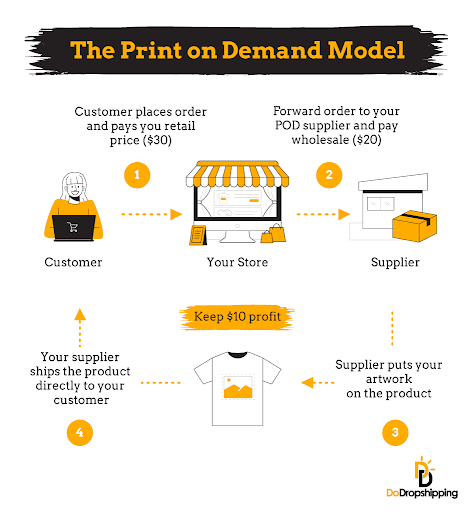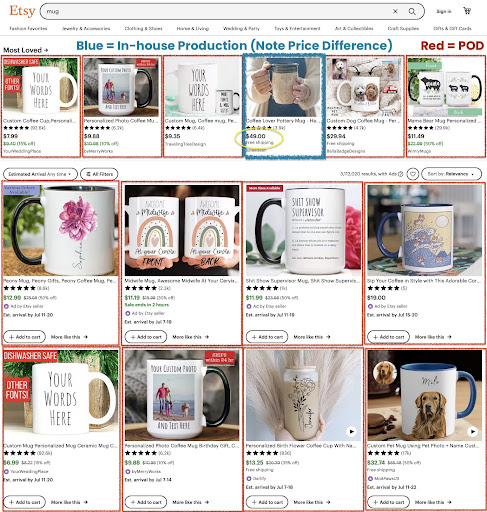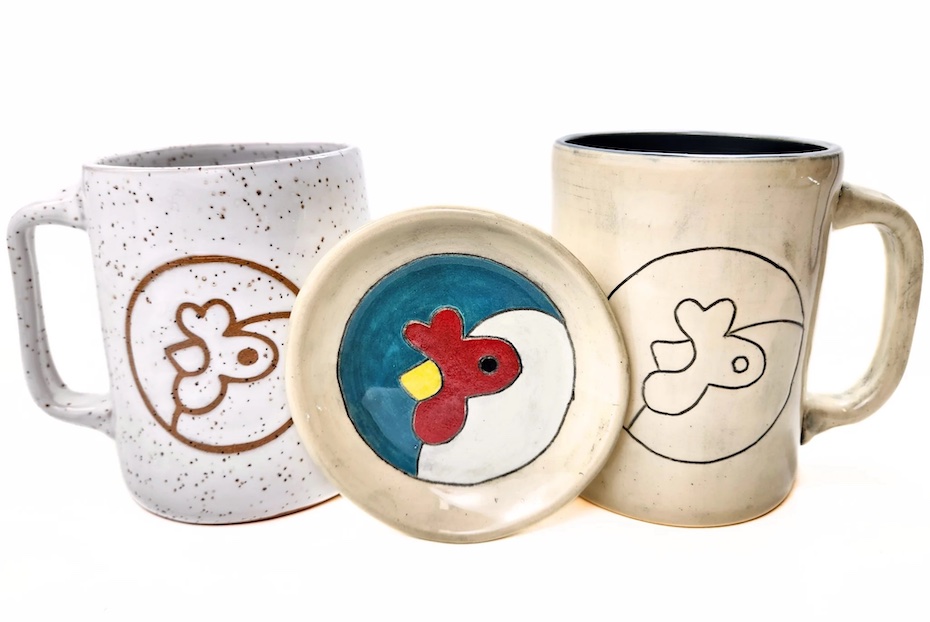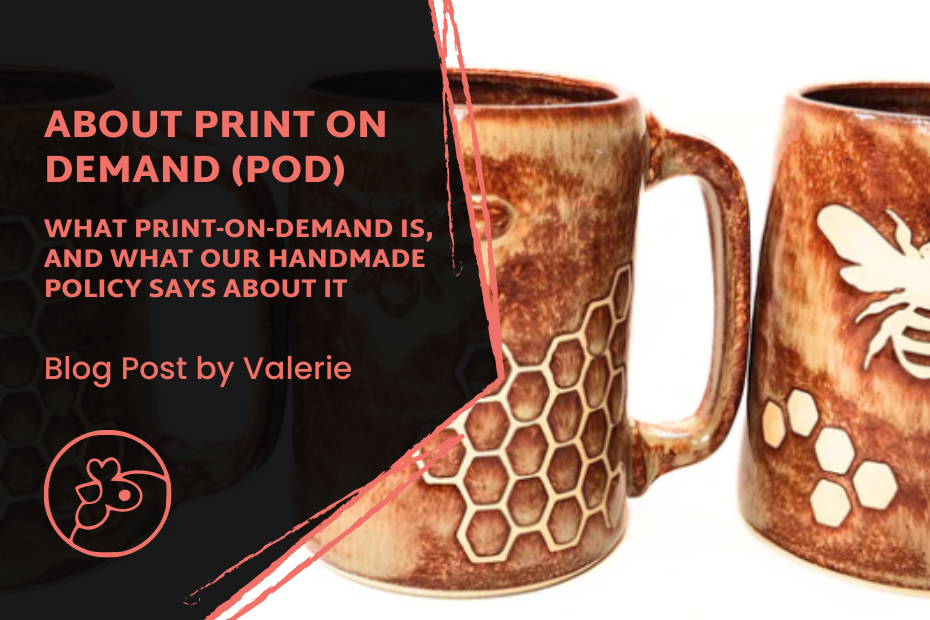What Print-on-Demand Is, and What Our Handmade Policy Says About It
Print-on-Demand (POD) is a hard-to-explain manufacturing outsourcing process that is growing rapidly in popularity – and controversy. In this post, we’ll try our best to explain what POD is, and how and why we’ve allowed it with careful limits in our Handmade Policy.
What Print-on-Demand (POD) Is
In our Handmade Policy, we define Print-on-Demand in the Glossary as:
“A special type of outsourcing that removes the artisan’s risk of being unable to sell the products that were created.“Print-on-Demand” (POD) is a printing technology and business process in which mass-produced “blank” products are printed with custom images and text “on demand” when the POD printer receives an order, allowing prints of single or small quantities. The printer provides mocked-up stock imagery for the artisan to post for sale on their selling channels. The order is printed and shipped directly to the customer. The artisan does not have to purchase inventory and does not touch it or inspect it. POD can be applied to a growing list of products, including print materials, basic apparel such as t-shirts and hats, and other mass-produced items like tumblers, bean bag covers, mouse pads, and plastic phone cases. Printful is an example of a POD service.”
Our Handmade Policy
Similar to the process of listing on a POD marketplace like Redbubble, Zazzle, or CafePress, when an artisan uses POD for their own store, they register an account with a POD service provider like Printify, Printful, or Printsource and upload their artwork. The service has a tool that applies their artwork to a template image of an item the service carries, making a “mock-up” photo of the final item that the artisan can use to list the product for sale.
For a “fix it and forget it” solution, platforms like Etsy and Amazon allow the artisan to sync the service directly with the marketplace, listing the item directly on their website and automatically placing the POD order with the POD service provider. Or, artisans can also simply take an order they’ve received from anywhere and place the order themselves. The POD order is shipped directly to the customer from the POD warehouse.
Dedicated artisans who care about the quality of their products and how it reflects on themselves can order a sample of the product they intend to sell from the POD service, so they can inspect it in person and make sure it represents their art before posting it for sale. This process of review, adjustment, and improvement is a part of the workmanship of risk, and it’s why we allow outsourcing in batches.
But for POD, this sample order process is an optional, expensive, and time-consuming step that not all artisans take. The way the POD service is set up encourages an artisan/entrepreneur to apply their artwork to many different products. In less than half an hour, one piece of artwork can turn into a mug, t-shirt, hoodie, blanket, mouse pad, and more – an entire store’s worth of inventory. This is how marketplaces can get flooded with Print-on-Demand: it’s too easy and fast, and it quickly outpaces the crafts that are laboriously made in-house and photographed.

In its purest sense, this is manufacturing “made to order.” But in its practical sense, it’s a “shortcut” to handmade production, and it causes customer confusion in marketplaces. And at its very worst, it’s being hawked like a get-rich-quick scheme for entrepreneurs who write articles like How To Make Money on Etsy Without Making Anything.
POD is a business model that has been supercharged in recent years by technology advantages, such as the introduction of Direct To Garment (DTG) printers in 1990s. It started with t-shirts, but the variety of products that can be purchased POD is growing every year.
Most shoppers probably don’t know what POD is, but they’ve almost certainly seen it or even purchased it. For example, below is a screenshot from the Etsy website that shows the results of a search for “mug.” All of the search results are highlighted with a red or blue outline.
Red results are outsourced mugs – almost certainly POD. These are mass-manufactured mugs that have custom artwork printed on them. Some of the listings are for little more than a printing service, e.g., “Your Words Here.” But some of the artwork is genuinely original. For example, the bottom right mug offers a custom pet portrait applied to a mug: the artistry is in the pet portrait, not the printing of the mug. Note the prices of most are in the $10-$20, with the exception of the pet portrait mug, an indication of the artisan’s labor time in making custom artwork.
Blue results are in-house produced handmade pottery: only one out of 14. Note its price is significantly higher than the others: $49, an indication of the artisan’s labor time and materials used in making the mug from clay. Incidentally, the only potter-made mug shown on the first page of results was paid for by the potter with an ad: the first row of results are all ads.

A common question at this point is: So why are we considering POD for the Artisans Cooperative marketplace at all? It’s not quite so simple.
Why We Like POD
POD is Absolutely Necessary Today for Certain Kinds of Artisans
POD has become particularly important for certain kinds of artisans: those selling photography, fine artwork, and the printed word, such as books. For photographers in particular, it risks their intellectual property rights to provide a digital, original copy of their photos.
And the practical nature of customers shopping for art to hang on their walls means they have an almost-infinite expectation of preferences for certain sizes, finishes, canvas materials, etc., to meet their decorating needs. A photographer couldn’t realistically stock all the possible combinations.
Importantly, for these artisans selling a photo as a print, or written words as a book, selling it in any size canvas or style of book is still a “faithful reproduction” of the original work. In its essence, the reproduction remains the same “thing” as the original work itself, in purpose, focus, and structure: a photo remains an image, and written word remains written word. In contrast, an artisan’s image applied by POD to a mug, blanket, or mouse pad changes from being an image to being a mug, blanket, or mouse pad. This is an important point we’ll come back to in a minute.
POD Increases Product Options for Some Artisans
For illustrators, digital artists, and designers, POD opens up a world of physical goods on which they can sell their artwork quickly, easily, and economically. This supports their careers.
POD Lowers the Barrier of Entry for Artisans Lacking Physical Space
Artisans with houses and garages are at an advantage over artisans in apartments: they have space to buy equipment and inventory. Artisans who don’t have storage space, are experiencing houselessness, or who are digital nomads don’t have the physical space to store inventory and shipping supplies. The POD company creates the product and ships it directly to the customer, so the artisan doesn’t need to store inventory or purchase equipment.
POD Lowers the Barrier of Entry for Low Income Artisans
Investing in an outsourced batch of custom-manufactured products, such as a production run of enamel pins, requires a significant upfront investment. With print materials in particular, the cost of running a small print run can cost almost as much as a large print run because of set-up fees. Not every artisan has the capital to invest in a risky production run.
POD Reduces Landfill Waste
Because the items are produced only when there is a buyer, POD reduces waste. If an artisan invests in a production run but can’t sell them all, they have created both financial waste and material waste. For example, the artisan who wants to do a run of t-shirts will have to guess which combination of sizes and colors to sell. It’s a common problem that they end up with say, too many size Smalls, or the color Red. Consumer preferences are hard to predict.
Why We Don’t Like POD
POD Dilutes the Marketplace Because Of Its Ease-of-Use
For an illustrator or designer, it’s very easy to take their designs, apply them to the POD company’s template, and export dozens of product listing photos and descriptions in minutes, while a potter or quilter would have to spent hours carefully crafting and photographing a piece before it’s listed. The end result is what we see everywhere on the internet, including Etsy, the marketplace is quickly overwhelmed by POD listings and the original handmade ones get diluted.
POD Makes Handmade Products Look Unfairly Expensive
Let’s say a shopper is looking for a rainbow-themed mug as a gift to celebrate a friend’s coming-out. When a shopper is looking at two rainbow mugs next to each other on the same screen that have the same message/theme, and one was mass produced but has original artwork that costs $10, and the other is an original handmade piece that costs $50, it can be hard for some shoppers to pull the trigger and voluntarily pay for the $50 mug over the $10. Their gifting purpose may have already been satisfied by the message, and choosing the $50 mug requires them to think hard about the ethics of each purpose. On our marketplace, we want to support artisans in their essential work: photographers and illustrators in faithful reproductions of their art, but also potters making pottery.
POD Creates Customer Confusion
Customers often don’t know what handmade even is anymore, partly thanks to the pervasiveness of POD on supposedly handmade marketplaces. It’s hard to know what handmade looks like when marketplaces categorize handmade and POD all together, with no differentiation between them. you’ve never seen it before.
POD Is Everywhere on the Internet – Does It Have to Be Here Too?
Some artisans who primarily create their work through in-house production feel harmed by the sheer quantity of POD mass-produced items on the internet masquerading as handmade. In our community survey, they argued that artisans can sell POD items pretty much everywhere else on the internet, so why does it have to impinge on the cooperative handmade marketplace? These artisans supported those that sell POD items linking to their other stores on their listings and pages, but objected to POD listings being part of our search results and shoppable items (such as, “Do you like this print? Get it on a pillowcase in my Redbubble store!”).

What Our Community Thinks About POD
In the early 2000’s, the early days of Etsy, “handmade” meant that only “in-house” production was allowed. This meant the artisans themselves, with their own hands and tools. There are many who still believe this should be the essential definition.
However, a lot has changed in the last twenty years, not least of which is that we have become more aware of the need to make access to income online equitable in a time of obscene income inequality. As Etsy experienced during its early growth, in practice the downside of this strict definition was two-fold: the artisan was burdened with doing all of the making to the point of frazzlement, and they could not grow their business beyond themselves. When Etsy introduced outside manufacturing (“Production Partners”), it was a controversial decision, and many believed it was the beginning of Etsy’s downfall.
Now, in the 2020’s, we had to approach a handmade definition for our marketplace with fresh eyes. And we found that our community believes that some outside production and artisanship can be compatible if well-defined, verified, and enforced.
In our Handmade Survey, which formed the basis for our Handmade Policy, we asked our community what they thought about POD. This is a difficult question and the results were nuanced:
- The community supported artisans using whatever tools or materials or production methods they needed to make a living on their original artwork, including POD.
- However, they definitely did not want the marketplace to be flooded with mass-produced items such as mouse pads, flags, socks, blankets, beanbag covers, pillows, water bottles, and wine glasses.
Trying to find an enforceable definition somewhere in between those two extremes, that would create the marketplace we all want to see, was very challenging for the Handmade Workgroup when it was creating the policy.
The survey results showed the community was open to possible restrictions on POD, such as only using co-op approved vendors, or restricting it to certain artisans or certain kinds of products.
However, of these options, limiting POD to only certain kinds of artisans felt anti-cooperative, anathema to the Handmade Definition Workgroup.
Limiting it to certain vendors / suppliers was intriguing, especially if we could limit it to values-aligned organizations like cooperatives or even only to fellow artisans on the marketplace. But ultimately, this felt out of scope for the Handmade Definition Workgroup: a great idea for the future but impossible to implement before we even had a functioning marketplace up and running.
However, throughout the survey, the community showed an exceptional and statistically higher level of support for producers of print materials: books, zines, canvases, photo reproductions, posters, which reproduce the original artwork in “faithful reproductions.” We could restrict the use of POD by certain types of products, and the community had clearly communicated what they thought these types of products should be.
The Handmade Definition Workgroup struggled with coming up with a policy on POD. Many times it was suggested that the policy be simple and pure: all POD or no POD. However, artisans from both sides of the spectrum had strong and reasonable objections for either one of those positions. It revealed a tension between crafters and artists.
A practical consideration held by the workgroup was that if they were too lenient about POD from the beginning, then it would be hard to rein it back if there was a problem. It would be easier to communicate and control a policy that was restrictive of POD in the beginning, and loosen it later with time, data, and experience.
Even after several rounds of discussion, the workgroup was unable to come to consensus (unanimous agreement) or consent (no objections) on POD. In the end, it had to resort to its third preference for decision-making, a vote, which resulted in our current policy: POD allowed for print materials only.
This was enforceable, and a workable compromise. Print material POD would still lower the barriers for digital illustrators and graphic designers while not directly competing with artisan-made products (and those artisans could also link to their other POD sites, such as their Redbubble stores). The key to differentiating between allowable POD for photography, fine artwork, and printed word, and disallowed POD for other types of physical products lay with the concept of “faithful reproductions” discussed above. And, the group reasoned that the policy could always be expanded and revisited in the future.
What Is Our Policy on Print-on-Demand (POD)
From the Handmade Policy:
Although artisans may in their judgment sometimes require production assistance (outsourcing) to the extent allowed by this policy, we will actively encourage, promote, and support artisans who produce their products using in-house production. Print-on-demand is a type of outsourcing only allowed under certain circumstances
Section 1.4, Handmade Policy
Print Materials
Our Handmade Policy
Primarily two-dimensional paper-based materials that reach intended audiences through written words or illustrations, such as zines, stickers, greeting cards, posters, books, fabric, and canvases.
About Artisans Cooperative
We are growing an online handmade marketplace for an inclusive network of creatives: a co-op alternative to Etsy.
Shop the marketplace!

I was curious if the team also looked at the quality of the POD products?
The Handmade Policy workgroup considered Limiting POD to certain vendors / suppliers – which could include such things as by quality or values-aligned mission. This was intriguing, but ultimately, this felt out of scope for the Handmade Definition Workgroup: a great idea for the future but impossible to implement before we even had a functioning marketplace up and running.
In cooperation, Valerie
Another benefit to using POD services which I didn’t see brought up is Safety. Artists have been victims of stalking, doxing, and abuse online and in real life. They cannot use their real names or ship items from their home giving away their address. Using POD creates a safe barrier between the artist and the customer who will get the item shipped to them from the manufacturer and not the artist. The world is a scary place. But I like the policy you have. It feels fair enough. And I absolutely love hand made things but for myself I use POD because of safety and only because of safety. If the world were a better place I’d be mailing handmade art to people. But I can’t.
That’s a great point, Jenny, thanks for sharing. -Valerie
Thank you for adding this take on Pod. Until I read your comment that had honestly never crossed my mind. I am sorry that you need the barrier from bad actors in the world but I am happy the option is there for you so you can still ultimately put your art into the world. Happy creating!
If you allow pod in this business model you are opening a box you wish you never opened. Pod has completely over run sites like etsy and eventually will over run this one.
Focus on what sellers and real artisans want, a venue to sell true hand made. The next generation who are currently in the 20-25 age range recognize the value of a true well made product and will pay for it.
Hi, Dave. We are being very selective in what we allow POD for – check out our Handmade Policy at the link above. We actually did decide on our POD stance because of our focus on what artisans and their supporters want – late 2022/early 2023 we ran a poll that 126 responded to, comprised of roughly twice as many artisans as supporters of handmade. The results were very specific about the different elements of POD, and that’s what we designed our policy around.
In cooperation, Erin
Am I correct in thinking that card/board games are acceptable under print media?
Yes! We already have some up on the site. Thanks for asking.
Yes! While Judith is correct that we allow handmade games on our marketplace, there are some additional nuances to consider regarding Print on Demand. We do allow card games and board games to be offered as POD, as it is a “faithful reproduction” of the original work and a primarily 2D print material (even though board games may have associated parts like meeples).
So basically if you just started the article saying you only allowed printed materials pod I could have saved 3 minutes of reading? Or do I not get something else from this article. ?? .
Quite frankly I find your differentiation quite funny as there are plenty of great artists that want to apply things on coffee mugs and keychains that they create the artwork and are quite sellable. Having just one example showing it at $49 is ridiculous as they are plenty of examples that are similarly priced with custom photography on mugs as a test one item very similar or lower price even than things that are pod with existing artwork
We wrote this article for a wide audience of people, so we felt it was necessary to explain what POD is before we explained what our policy was on it. Our POD policy was designed by a diverse committee of people to reflect the will of our community, as shared in our Handmade Survey. Thank you for your feedback.
And I still don’t know whether you just allow me to sell without giving you $1,000 as a startup fee. I don’t think I sell $1,000 in entire year but I enjoy what I do sell on Etsy which is small and custom painted cows.
As of this writing on Dec 6, 2023, we are currently only allowing members to open stores on our marketplace, but we are planning to allow non-members soon. There are multiple membership levels, payment plans, and non-cash options, requiring as little as $10 USD to join. We do not yet have a date for non-members but you can join our waitlist to be notified.
– More information on membership
– More information on our planned roll-out of the marketplace
– To join our seller waitlist